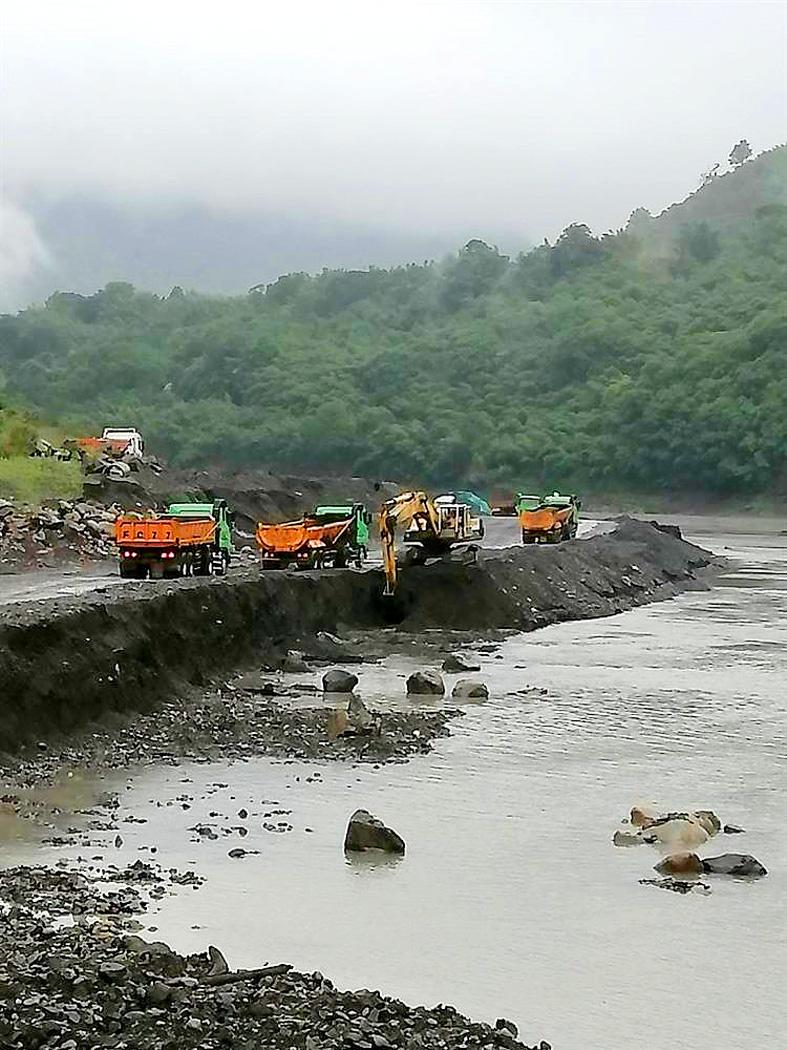Taiwan is facing the most severe water shortage in 56 years due to a lack of rainfall, but it is also the best time for reservoir dredging, as lower water levels expose silt and sand, the Water Resources Agency said in a statement on Friday.
As many reservoirs in Taiwan have over the years accumulated too much sediment and are losing storage capacity, the government has increased dredging efforts, the agency said in a statement.
Last year, dredging at the nation’s reservoirs had removed 14.4 million cubic meters of sediment, the most on record and about 2.6 times the annual average, the agency said.

Photo courtesy of Water Resources Agency
In the first three months of this year, the government had dredged 3.57 million cubic meters of sediment from reservoirs, an increase of 280,000 cubic meters from the 3.29 million cubic meters in the same period of last year, doubling the annual average of 1.79 million cubic meters over the past 10 years, the agency said.
“We will continue to dispatch more machinery and workers to increase excavation and maximize dredging,” the statement said.
The volume of dredging was in the past relatively small, as the government mainly used excavators and truck transportation for reservoir dredging.
However, the volume of dredging has continued to rise, due to better governance and management, including conservation of upstream reservoir catchment areas, excavation of bottom sediment in the reservoirs and the use of hydraulic systems for sand discharge, it said.
The government last year removed 3.34 million cubic meters of sediment from the Shihmen Reservoir (石門水庫) in Taoyuan and 3.82 million cubic meters from the Zengwen Reservoir (曾文水庫) in Chiayi County, which not only exceeded the annual accumulation of sediment, but also helped enhance the reservoirs’ capacity by 1.2 million cubic meters and 1.55 million cubic meters respectively, the agency said.
As the shortage persists, semiconductor companies, which use large amounts of water, are increasingly taking emergency measures to stabilize production.
As Taiwan Semiconductor Manufacturing Co (TSMC, 台積電) and United Microelectronics Co (UMC, 聯電) together account for more than 60 percent of the global foundry market, production disruption due to the water shortage would affect technology production worldwide.
TSMC has begun trucking water from reservoirs in northern Taiwan to its fabs in southern Taiwan. Local media last week reported that the chipmaker would purchase 100 water trucks, after the government further tightened water restrictions for some areas.
Minister of Economic Affairs Wang Mei-hua (王美花) on Friday said that she was not sure about the size of the water truck purchase, but believed that it is part of the company’s contingency plan to ensure uninterrupted production.
However, the water shortage would have limited effect on semiconductor companies, as the government has pledged to increase water supply to the firms, she said.
UMC said it has also purchased water trucks, while other semiconductor firms might follow suit, local media reported.
If the shortage continues through the second half of this month, water levels at reservoirs would fall further, and trucking water to factories would become more common, the reports said.

Nvidia Corp’s demand for advanced packaging from Taiwan Semiconductor Manufacturing Co (TSMC, 台積電) remains strong though the kind of technology it needs is changing, Nvidia CEO Jensen Huang (黃仁勳) said yesterday, after he was asked whether the company was cutting orders. Nvidia’s most advanced artificial intelligence (AI) chip, Blackwell, consists of multiple chips glued together using a complex chip-on-wafer-on-substrate (CoWoS) advanced packaging technology offered by TSMC, Nvidia’s main contract chipmaker. “As we move into Blackwell, we will use largely CoWoS-L. Of course, we’re still manufacturing Hopper, and Hopper will use CowoS-S. We will also transition the CoWoS-S capacity to CoWos-L,” Huang said

Nvidia Corp CEO Jensen Huang (黃仁勳) is expected to miss the inauguration of US president-elect Donald Trump on Monday, bucking a trend among high-profile US technology leaders. Huang is visiting East Asia this week, as he typically does around the time of the Lunar New Year, a person familiar with the situation said. He has never previously attended a US presidential inauguration, said the person, who asked not to be identified, because the plans have not been announced. That makes Nvidia an exception among the most valuable technology companies, most of which are sending cofounders or CEOs to the event. That includes

INDUSTRY LEADER: TSMC aims to continue outperforming the industry’s growth and makes 2025 another strong growth year, chairman and CEO C.C. Wei says Taiwan Semiconductor Manufacturing Co (TSMC, 台積電), a major chip supplier to Nvidia Corp and Apple Inc, yesterday said it aims to grow revenue by about 25 percent this year, driven by robust demand for artificial intelligence (AI) chips. That means TSMC would continue to outpace the foundry industry’s 10 percent annual growth this year based on the chipmaker’s estimate. The chipmaker expects revenue from AI-related chips to double this year, extending a three-fold increase last year. The growth would quicken over the next five years at a compound annual growth rate of 45 percent, fueled by strong demand for the high-performance computing

TARIFF TRADE-OFF: Machinery exports to China dropped after Beijing ended its tariff reductions in June, while potential new tariffs fueled ‘front-loaded’ orders to the US The nation’s machinery exports to the US amounted to US$7.19 billion last year, surpassing the US$6.86 billion to China to become the largest export destination for the local machinery industry, the Taiwan Association of Machinery Industry (TAMI, 台灣機械公會) said in a report on Jan. 10. It came as some manufacturers brought forward or “front-loaded” US-bound shipments as required by customers ahead of potential tariffs imposed by the new US administration, the association said. During his campaign, US president-elect Donald Trump threatened tariffs of as high as 60 percent on Chinese goods and 10 percent to 20 percent on imports from other countries.